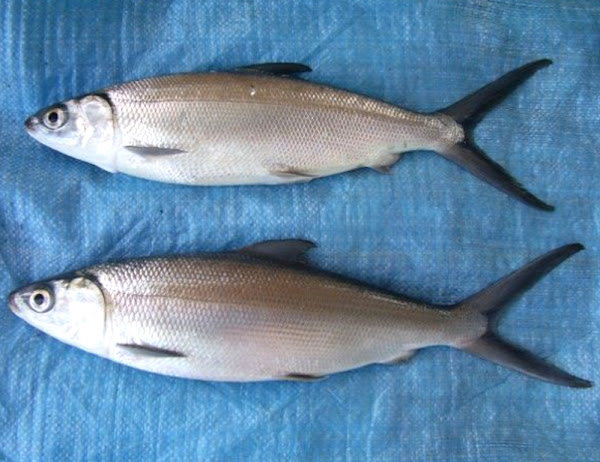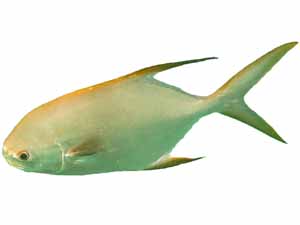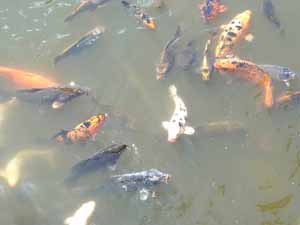The Milkfish is a silvery marine food fish which is the only living member of the family Chanidae. It is also called by many other different names such as Bandeng, Bangos, Awa, Ibiya and Bolu.
It is the national fish in the Philippines. It is a very old fish species, and fossils of this family date from as far back as the Cretaceous Period (145.5 to 65.5 million years ago).
The Milkfish aquaculture fist occurred around 800 years ago in the Philippines and spread in Indonesia, Taiwan and into the Pacific.
Traditional Milkfish aquaculture relied upon restocking ponds by collecting wild fry. And this led to a wide range of variability in quality and quantity between seasons and reasons.
Farmers first spawned breeding fish successfully in the late 1970s. But they were hard to obtain and produced unreliable egg viability.
The fist spontaneous spawning happened in sea cages in 1980. These eggs were found to be sufficient to generate a constant supply for farms. Read some more information about the Milkfish below.
Milkfish Characteristics
The Milkfish has an elongate and almost compressed body, with a generally symmetrical and streamlined appearance. It’s body color is olive green, with silvery flanks and dark bordered fins. It has one dorsal fin, falcate pectoral fins and a sizable forked caudal fin.
Mouth of this fish is small and toothless. Lower jaw with small tubercle at tip, fitting into notch in upper jaw. There are no bony gular plate between arms of lower jaw.
These fish generally have 13-17 dorsal soft rays, 8-10 anal soft rays and 31 caudal fin rays. Caudal fin is large and deeply forked with large scale flaps at base in the mature fish.[1]
The Milkfish can reach around 1.8 meter body length, but are most often no more than 1 meter in length. They reach a weight of about 14 kg.[2]

Diet
The Milkfish generally feed on cyanobacteria, algae and small invertebrates. In the past, traditional feeding practices for milkfish grow-out production have consisted of natural food. Or a combination of macroalgae and phytoplankton encouraged by fertilization.
However, special commercial feeds were developed for Milkfish in the 1980s, and the feed became almost exclusively used.
Nowadays feed supplies are now manufactured commercially in the form of starters, growers and finishers. These feeds are administered according to the production stage and age of the Milkfish.
Breeding
The Milkfish tend to school around coasts and islands with coral reefs. The young fry generally live at sea for 2 to 3 weeks, and then migrate during the juvenile stage to mangrove swamps, estuaries and sometimes lages.
And they return to sea to become mature and also for reproducing. The females generally spawn at night, and they lay up to 5 million eggs in saline shallow waters.
Broodstocks reach maturity in 5 years in large floating cages, but can take about 8 to 10 years in ponds and concrete tanks. Generally fist spawning broodstocks tend to be smaller than adults caught from the wild.
As a result, fist time spawners produce fewer eggs than wild adults, but larger and older broodstocks produce as many eggs as wild adults for similar size. Broodstocks averaging 6 kg, and of about 8 years old produce 3-4 million eggs.
Uses
It is a popular fish species that is widely consumed in many parts of the world. This fish is an important source of protein and other essential nutrients, and it is also used in a variety of dishes and culinary traditions.
Special Notes
Milkfish are euryhaline, stenothermic fish. They can be cultured in brackishwater, freshwater and marine waters. But they can be cultured only in the tropical and subtropical Indian and Pacific Oceans, where temperature is greater than 20 °C.
They commonly live in tropical offshore marine waters around island and along continental shelves, at depths of 1 to 30 meters. They also frequently enter estuaries and rivers. The Milkfish are long lived fish, and they can life for up to 15 years.
The Milkfish is a very important seafood in Southeast Asia and some Pacific Islands. It has great popularity in the market, because it is notorious for being much bonier than other food fish.

Generally fish weighting 200 to 400 grams are harvested and marketed. The Milkfish is generally marketed fresh or chilled, whole or deboned, frozen, or processed. However, review full breed profile of this fish species in the chart below.
| Name | Milkfish |
| Kingdom | Animalia |
| Phylum | Chordata |
| Class | Actinopterygii |
| Order | Gonorynchiformes |
| Family | Chanidae |
| Genus | Chanos |
| Species | C. chanos |
| Binomial Name | Chanos chanos |
| Other Names | Also known as Bandeng, Bangos, Awa, Ibiya and Bolu |
| Breed Purpose | Mainly food |
| Special Notes | Economically a very important fish species of South Asia, very tasty, highly prized in the market, these fish can be cultured in brakishwater, freshwater and marine waters, long lived fish |
| Breeding Method | Natural and artificial |
| Weight | Generally harvested when they reach 200-400 grams in commercial farms, but can reach up to 14 kg |
| Water Type | Brakishwater, freshwater and marine water |
| Climate Tolerance | Native climate |
| Body Color | Silvery |
| Rarity | Common |
| Availability | South Asia |







I am not very great with English but I line up this very easy to translate.
Many thanks for this! 🙏